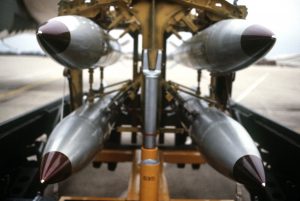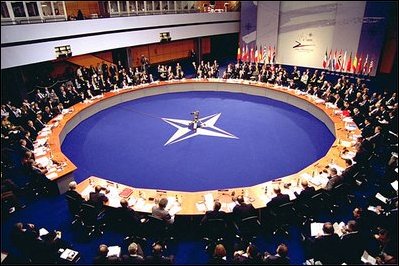NATO
The North Atlantic Treaty Organization (NATO) is a military alliance consisting of 31 member countries in North America and Europe. NATO’s highest decision-making body is the North Atlantic Council, which consists of representatives of all NATO member states. NATO headquarters is in Brussels.
The purpose of NATO was to protect the freedom and security of member countries by political as well as military means. The enemy used to be the communist Soviet Union and its allies, who in 1955 formed a similar military alliance, the Warsaw Pact, which was disbanded in 1991.
An armed attack on one or more of the member states is considered an attack against all NATO countries according to NATO’s founding document, Article 5. It is up to each member state to take decisions to defend other members under attack.
NATO’s nuclear weapons policy
Nuclear weapons are part of NATO’s military strategy and through NATO, the US has long had nuclear weapons deployed in Europe. During the NATO summit in Lisbon in 2010, a new strategic document was adopted in which the relationship to nuclear weapons was clarified.
In the new strategy, it was then made clear that NATO is a nuclear weapons alliance through Article 17 which stipulates “As long as nuclear weapons exist in the world, NATO will remain a nuclear weapons alliance.”. NATO has no nuclear weapons of its own but has access to the nuclear weapons of the United States and Great Britain. In Europe, there are approximately 100 nuclear weapons deployed in Germany, the Netherlands, Belgium, Italy and Turkey. France’s nuclear weapons are not part of NATO’s nuclear arsenal, but may be used in connection with certain operations if France deems it appropriate.
The Nuclear Planning Group is a forum where defense ministers from both NATO’s nuclear-weapon states and non-nuclear-weapon states discuss nuclear issues and review the alliance’s nuclear weapons policy. All decisions in the Nuclear Planning Group are made by consensus and it is voluntary for states to join the group, France being the only country outside the group.
NATO and the NPT
It is a requirement for all NATO members to be members of the Non-Proliferation Treaty.
At the Non-Proliferation Treaty meetings, the American nuclear weapons that are placed in Europe through NATO are sometimes debated. Article 1 of the NPT prohibits nuclear-weapon states from transferring nuclear weapons to non-nuclear-weapon states. Article 2 requires that nuclear-weapon-free states not receive nuclear weapons or take control of nuclear weapons. The United States argues that the deployment of nuclear weapons in Europe does not violate the Non-Proliferation Treaty because control of the weapons is not handed over to the host country. Russia, for its part, claims that it certainly violates the Non-Proliferation Treaty, and is a threat and provocation.
The US also believes that the non-proliferation agreement ceases to apply in wartime and the transfer of control of the nuclear weapons to the host country in the event of a possible outbreak of war would therefore be legal. However, the 1985 NPT Review Conference determined that the treaty applies in all circumstances.
Nuclear weapons in Europe
In the early 1970s, there were approximately 7,300 nuclear weapons deployed in Europe. Protests from both civil society and governments meant that the number of nuclear weapons was reduced and at the moment it is about 100.
NATO’s nuclear weapons policy is based, among other things, on the concept of “nuclear sharing“. This means that nuclear weapons are located on the territory of nuclear-weapon-free states. “By promoting European stability, helping to deter threats related to the use of weapons of mass destruction and contributing to deterring the use of such weapons, NATO’s nuclear weapons policy serves not only the interests of Allies, but also partner countries and Europe as a whole,” it says read in the 2006 NATO manual. In peacetime, nuclear weapons are under US control and in the event of war, the US president could authorize the use of the weapons and transfer them for use to the host country. The host countries assist with their own warplanes, which must thus be able to carry nuclear warheads.
Russia has tactical nuclear weapons in Europe based on Russian territory. NATO sometimes argues that it keeps its nuclear weapons deployed in Europe in order to negotiate a reduction in Russian weapons in Europe.
Gravity Bomb
All of NATO’s deployed nuclear weapons are of the B61 type, which are intended to be dropped from aircraft as gravity bombs. The bombs fall freely and have poor accuracy. Of course, such weapons have little military value. The bombs, on the other hand, are considered to have had a political value and act as a deterrent. They are considered to constitute a kind of pledge that the United States is prepared to defend Europe.

Four nuclear gravity bombs on a bomb cart.
There is a modernization of all these bombs which will be deployed sometime between 2022-2024. The new bombs will be steerable and the bombs could then be given a military function to hit the adversary’s military targets, such as bases for missiles or combat command.
The new B61 bombs will be longer and cannot be delivered with the countries’ current fighter planes, but new planes must be purchased. These plans, both on the modernization of the B61 and on the need for new aircraft have met with resistance in the relevant NATO countries, not least because of the high costs of purchasing new fighter aircraft and because the bombs are considered to be outdated and pointless.
Countries’ national laws
The United States has several times withdrawn its nuclear weapons from other countries. Canada, Greece and Denmark (Greenland) have had nuclear weapons deployed on their territories, but they have been withdrawn. Several NATO states, including Norway, have a policy towards NATO that nuclear weapons may not be placed on their soil during peacetime. Spain and Lithuania go even further and have national legislation against the placement of nuclear weapons on their territory in both peacetime and wartime.
Sources and more information
Active Engagement, Modern Defence, Strategic Concept 2010, NATO
U.S. Nuclear Weapons In Europe, Hans M. Kristensen, Federation of American Scientist, FAS
United States Nuclear Weapons 2021, Hans M. Kristensen and Matt Korda, Bulletin of Atomic Scientist
Nuclear Planning Group (NPG), NATO
Upgrades At US Nuclear Bases In Europe Acknowledge Security Risk, Hans M. Kristensen, Federation of American Scientist, FAS
Nuclear Umbrella Arrangements and the Treaty on the Prohibition of Nuclear Weapons, International Human Rights Clinic, Harvard Law School





